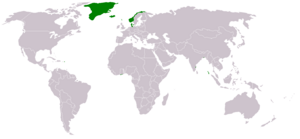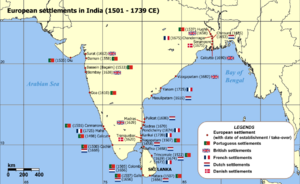Danish Empire
In various forms, Denmark has had colonial possessions since the beginning of the 13th century, when it obtained possessions in Estonia. In personal union with Norway, Denmark-Norway had possession of old Norwegian holdings, Greenland, the Faroe Islands, Orkney, Shetland and Iceland. In the 17th century, following territorial losses on the Scandinavian Peninsula, Denmark-Norway began to develop colonies, forts, and trading posts in Africa, the Caribbean, and India.
Christian IV first initiated the policy of expanding Denmark's overseas trade, as part of the mercantilist wave that was sweeping Europe. Denmark's first colony was established at Tranquebar, or Trankebar, on India's southcoast in 1620. Admiral Ove Gjedde led the expedition that established the colony.
The only remaining vestige of this empire, and its only substantial territory ever, is that of Greenland, whose colonial status ceased in 1953, and is now an autonomous region of the Danish state. The Faroe Islands have had autonomy within Denmark since 1948.
India
Denmark maintained a scattering of small colonies and trading posts throughout the Indian sub-continent (but not Ceylon/Sri Lanka) from the 17th to 19th centuries, after which most were sold or ceded to Britain which had become the dominant power there.
The colony at Trankebar was kept for over 200 years, with a few interruptions, until it was sold to the British in 1845. Trankebar was never an enormously profitable venture, but it was still something of a success.
In 1755 Denmark acquired the village of Serampore (Frederiksnagore), and later the towns of Achne and Pirapur. They are located about 25 kilometres north of Calcutta. In 1829 a Danish university was established at Serampore, which still exists today. These towns were also sold to Britain in 1845. Other colonial ventures include colonization attempts of Dansborg and the Nicobar Islands, called Frederik Øerne ("Frederik Islands") by the Danes.
Caribbean
Denmark acquired the island of St. Thomas in 1671, St. Jan (today St. John) in 1718, and bought St. Croix from France in 1733. All of the islands' economies were based primarily on sugar. These islands were known as the Danish West Indies and were eventually sold to the United States in 1917 for 25 million dollars. The Danes had been looking to get rid of the islands for some decades as the economies of the islands had been declining. The United States hoped to use them as naval bases. Since 1917, the islands have been known as the U.S. Virgin Islands.
Africa
Denmark maintained a number of tradings stations and four forts on the Gold Coast in west Africa, especially around modern day Ghana. The three trading stations were Fort Frederiksborg (Kpompo), Fort Christiansborg, (by Accra in 1661) that was purchased from Sweden, and Frederiksberg. The forts were Fort Prinsensten built in 1784, Fort Augustaborg from 1787, Fort Friedensborg and Fort Kongensten, several of which are ruins today. Of these, only one is still used today, Fort Christiansborg, which is the Ghanaian president's residence in Ghana. Plantations were established by Frederiksborg, but they failed. Fort Christiansborg became the base for Danish power in west Africa, and the centre for slave trade to the Danish West Indies. In 1807, Denmark's African business partners were suppressed by the Ashanti, which led the abandonment of all trading stations. Denmark sold its forts to Great Britain in 1850.
See also
- Danish colonization of the Americas
- List of former Danish colonies
External links
- List of Danish colonial possessions List of Danish colonial possessions
Template:Colonialism
cs:Dánské kolonie da:Danmarks kolonitid de:Dänische Kolonien es:Imperio colonial danés fr:Empire colonial danois hr:Dansko kolonijalno carstvo he:האימפריה הדנית it:Impero coloniale danese hu:Dán tengerentúli gyarmatok nl:Deense koloniën ja:デンマーク海上帝国 sv:Danska kolonier zh:丹麥殖民地
Credits
New World Encyclopedia writers and editors rewrote and completed the Wikipedia article in accordance with New World Encyclopedia standards. This article abides by terms of the Creative Commons CC-by-sa 3.0 License (CC-by-sa), which may be used and disseminated with proper attribution. Credit is due under the terms of this license that can reference both the New World Encyclopedia contributors and the selfless volunteer contributors of the Wikimedia Foundation. To cite this article click here for a list of acceptable citing formats.The history of earlier contributions by wikipedians is accessible to researchers here:
The history of this article since it was imported to New World Encyclopedia:
Note: Some restrictions may apply to use of individual images which are separately licensed.

